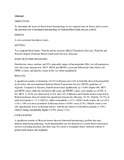| dc.description.abstract | OBJECTIVES:
To determine the status of blood donor haematology in two regional sites in Kenya and to assess the potential role of automated haematology in National blood bank process control.
DESIGN:
A cross sectional descriptive study.
SETTING:
Two regional blood banks--Nairobi and its environs (Blood Transfusion Services, Nairobi) and Western Region (National Blood Transfusion Services, Kisumu).
MAIN OUTCOME MEASURES:
Distribution, mean, median, and 95% percentile ranges of haemoglobin (Hb), red cell parameters (red cell count, haematocrit, MCV, MCH and MCHC), total and differential white blood cell (WBC) counts, and platelet counts in the two donor populations.
RESULTS:
A significant number of donations (16.5% in Kisumu and 3.4% in Nairobi) showed haemoglobin levels below the recommended National Blood Transfusion Service (NBTS) guideline of 42g/unit. Compared to Kisumu, Nairobi donors had significantly (p < 0.001) higher Hb, MCV and MCH values while the red blood cell counts and MCHC values were similar (p > 0.05). A low MCV (< 78 fl) was observed in 12.4% and 3.4% of Kisumu and Nairobi donors respectively. Both populations showed similar but significant frequencies (Kisumu, 21.3%; Nairobi, 18.7%) of mild neutropenia (< 1.5 x 10(9)/1), while eosinophilia (> 0.5 x 10(9)/1 in the tropics the cut off is > 0.6 x 109) was more prominent in Kisumu donors (18.8% versus 8.5%). Platelet counts were also significantly lower in Kisumu donors, with the prevalence of thrombocytopenia (< 150 x 10(9)/1) being considerably higher (15.9% versus 3.7%).
CONCLUSIONS:
A significant number of Kenyan donors showed abnormal haematology profiles that may indicate underlying pathology. Such abnormalities are not detected by current blood transfusion services screening practices and there may be a need to strengthen donor selection criteria to protect both donors and recipients. | en |

